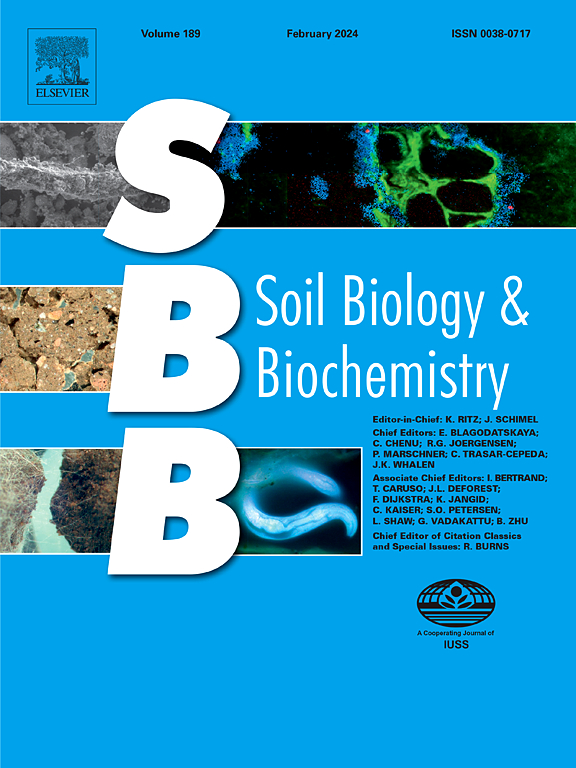温带地区的粘结作用通过非生物因子介导凋落物的分解
IF 9.8
1区 农林科学
Q1 SOIL SCIENCE
引用次数: 0
摘要
大多数温带树木在秋天落叶。然而,一些属,典型的山毛榉和橡树,保留了很大一部分的枯叶,直到下一个生长季节开始,这种现象被称为粘接。脱落和衰老叶片暴露的根本不同的条件有可能大大改变凋落物的分解。然而,粘结作用在多大程度上影响温带生态系统的分解仍然未知,这阻碍了我们对碳和营养循环的理解。为了解决这一难题,本研究通过野外操作实验,量化了温带生态系统中脱落叶所暴露的主要因子太阳辐射和降水对脱落叶衰老后相对于直接在有机层分解的叶片分解的影响。栎属和Fagus属的叶片在有机层分解前暴露在太阳辐射下,其质量损失明显高于直接在有机层分解的叶片(37% vs. 23%)。当叶片暴露于太阳辐射和降水中时,这种效应进一步放大(累积质量损失约50%或更多)。傅里叶红外光谱分析表明,仅在太阳辐射和太阳辐射和降水处理下,木质素-纤维素复合物的破坏和释放的化合物的浸出分别加速了叶片的分解。我们认为粘结是凋落物分解的一个不可或缺的驱动因素,并强调在温带生态系统中考虑碳和养分循环中的粘结。本文章由计算机程序翻译,如有差异,请以英文原文为准。
Marcescence in temperate regions mediates tree litter decomposition through abiotic factors
Most temperate trees shed their senescent leaves in autumn. However, some genera, typically beech and oak, retain a large portion of their dead leaves until the start of the subsequent growing season, a phenomenon termed marcescence. The fundamentally different conditions marcescent and shed senescent leaves are exposed to have the potential to substantially alter litter decomposition. The extent to which marcescence affects decomposition in temperate ecosystems, however, remains unknown, which hampers our understanding of carbon and nutrient cycles. Here, we aimed to resolve this dilemma in a manipulative field experiment by quantifying the effect of solar radiation and precipitation, the major factors marcescent leaves are exposed to in temperate ecosystems, on the decomposition of marcescent leaves relative to that of leaves directly decomposing in the organic layer after their senescence.
Exposure of leaves from the genera Quercus and Fagus to solar radiation before decomposition in the organic layer resulted in a considerably higher mass loss for those leaves than for leaves decomposing directly in the organic layer (37 vs. 23 %). This effect was further amplified upon exposure of leaves to both solar radiation and precipitation (cumulative mass loss of ∼50 % or more). Leaf chemistry analyses via Fourier-transform infrared spectroscopy suggested that disruption of ligno-cellulose complexes and leaching of the released compounds in the solar radiation only and solar radiation and precipitation treatments, respectively, accelerated leaf decomposition. We identify marcescence as an integral driver of litter decomposition and highlight the need to consider marcescence in carbon and nutrient cycling in temperate ecosystems.
求助全文
通过发布文献求助,成功后即可免费获取论文全文。
去求助
来源期刊

Soil Biology & Biochemistry
农林科学-土壤科学
CiteScore
16.90
自引率
9.30%
发文量
312
审稿时长
49 days
期刊介绍:
Soil Biology & Biochemistry publishes original research articles of international significance focusing on biological processes in soil and their applications to soil and environmental quality. Major topics include the ecology and biochemical processes of soil organisms, their effects on the environment, and interactions with plants. The journal also welcomes state-of-the-art reviews and discussions on contemporary research in soil biology and biochemistry.
 求助内容:
求助内容: 应助结果提醒方式:
应助结果提醒方式:


